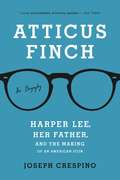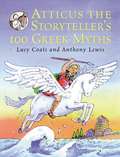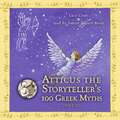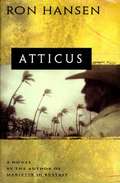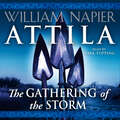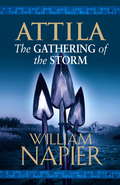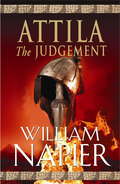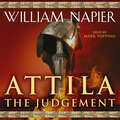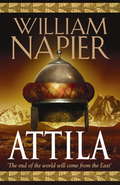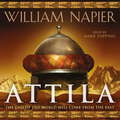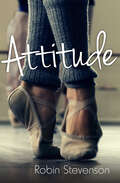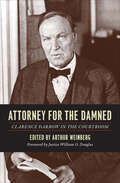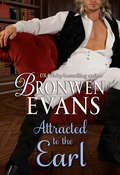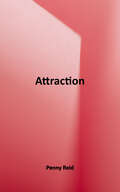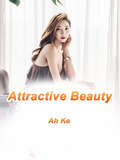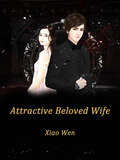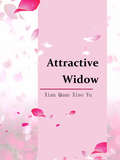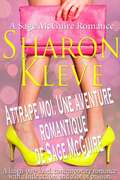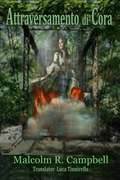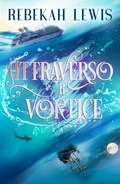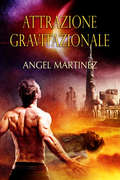- Table View
- List View
Atticus Finch: The Biography
by Joseph CrespinoWho was the real Atticus Finch? A prize-winning historian reveals the man behind the legend The publication of Go Set a Watchman in 2015 forever changed how we think about Atticus Finch. Once seen as a paragon of decency, he was reduced to a small-town racist. How are we to understand this transformation? In Atticus Finch, historian Joseph Crespino draws on exclusive sources to reveal how Harper Lee's father provided the central inspiration for each of her books. A lawyer and newspaperman, A. C. Lee was a principled opponent of mob rule, yet he was also a racial paternalist. Harper Lee created the Atticus of Watchman out of the ambivalence she felt toward white southerners like him. But when a militant segregationist movement arose that mocked his values, she revised the character in To Kill a Mockingbird to defend her father and to remind the South of its best traditions. A story of family and literature amid the upheavals of the twentieth century, Atticus Finch is essential to understanding Harper Lee, her novels, and her times.
Atticus the Storyteller's 100 Greek Myths
by Anthony Lewis Lucy Coats<p>Atticus the Storyteller is determined to take part in the great Storytelling Festival near Troy. He leaves his family in Crete and sets off on a year-long journey round Greece with his donkey, Melissa; and wherever he goes he tells his favourite myths to anyone who'll listen. <p>The 100 myths include all the favourites, such as the wanderings of Odysseus, the labours of Heracles, the stories of King Midas, Daedalus and Icarus, and Theseus and the Minotaur. Atticus's journey takes the reader to all the sites of the myths and gives a captivating glimpse of how life was lived in Ancient Greece. <p>This is an unparalleled introduction to the Greek myths for younger children, excitingly told, wonderful to read aloud, and illustrated on every opening with lively, engaging, colourful pictures full of authentic detail. In Orion's tradition of extra-large great-value story books, this is an outstandingly good resource for every family.</p>
Atticus the Storyteller: 100 Stories from Greece
by Lucy CoatsAtticus the Storyteller is determined to take part in the great Storytelling Festival near Troy. He leaves his family in Crete and sets off on a year-long journey round Greece with his donkey, Melissa; and wherever he goes he tells his favourite myths to anyone who'll listen.The 100 myths include all the favourites, such as the wanderings of Odysseus, the labours of Heracles, the stories of King Midas, Daedalus and Icarus, and Theseus and the Minotaur.Volume 3, read by Simon Russell Beale.(P)2004 Orion Publishing Group.Ltd
Atticus: A Novel
by Ron HansenAtticus, a Colorado rancher and oilman, gets word that his younger son Scott who has been living as an artist in Mexico for some time, has committed suicide. He goes to the Mexican village to bring back the body for burial, and while there hopes to learn more about the son with whom he's been out of contact. He's an intelligent and perceptive man, and in Scott's house and studio, and in conversations with his girlfriend, things don't seem quite right. He begins to think that Scott did not commit suicide but was murdered He's determined to find the murderer and bring him to justice.
Attila: The Gathering of the Storm
by William NapierThe gripping and bloody story of one of history's most infamous and enigmatic villains - part II in the ATTILA trilogyThe 5th century has dawned in blood. The young boy exiled thirty years ago has grown into a man. One stormy autumn day, a mysterious rider is seen out on the plains. Attila has returned, his sentence served, to claim his kingdom. He will ride out at the head of no more than one hundred chosen men, driven by the ambition to unite all the feuding Hunnish and Scythian tribes under single banner and a single king. An impossible ambition. For Attila and his chosen men must triumph over blizzards and deserts, bandit kings and hidden mountain kingdoms, and furious battle with the terrible Kutrigur Huns. But all will flock to his banner, answer his call. His power is mysterious and inexpressible, his strength of character and iron will cannot be opposed. And far to the west lies a promised empire both fabulously wealthy and tottering to its knees. An empire full of gold and silver and dark-eyed slavegirls - the Empire of Rome. And this strange horde from out of the Scythian wilderness will bring a night to fall on that Empire like no other¿
Attila: The Gathering of the Storm (Attila Ser. #2)
by William NapierThe gripping and bloody story of one of history's most infamous and enigmatic villains - part II in the ATTILA trilogyThe 5th century has dawned in blood. The young boy exiled thirty years ago has grown into a man. One stormy autumn day, a mysterious rider is seen out on the plains. Attila has returned, his sentence served, to claim his kingdom. He will ride out at the head of no more than one hundred chosen men, driven by the ambition to unite all the feuding Hunnish and Scythian tribes under single banner and a single king. An impossible ambition. For Attila and his chosen men must triumph over blizzards and deserts, bandit kings and hidden mountain kingdoms, and furious battle with the terrible Kutrigur Huns. But all will flock to his banner, answer his call. His power is mysterious and inexpressible, his strength of character and iron will cannot be opposed. And far to the west lies a promised empire both fabulously wealthy and tottering to its knees. An empire full of gold and silver and dark-eyed slavegirls - the Empire of Rome. And this strange horde from out of the Scythian wilderness will bring a night to fall on that Empire like no other¿
Attila: The Gathering of the Storm (Attila Ser. #2)
by William NapierThe gripping and bloody story of one of history's most infamous and enigmatic villains - part II in the ATTILA trilogyThe 5th century has dawned in blood. The young boy exiled thirty years ago has grown into a man. One stormy autumn day, a mysterious rider is seen out on the plains. Attila has returned, his sentence served, to claim his kingdom. He will ride out at the head of no more than one hundred chosen men, driven by the ambition to unite all the feuding Hunnish and Scythian tribes under single banner and a single king. An impossible ambition. For Attila and his chosen men must triumph over blizzards and deserts, bandit kings and hidden mountain kingdoms, and furious battle with the terrible Kutrigur Huns. But all will flock to his banner, answer his call. His power is mysterious and inexpressible, his strength of character and iron will cannot be opposed. And far to the west lies a promised empire both fabulously wealthy and tottering to its knees. An empire full of gold and silver and dark-eyed slavegirls - the Empire of Rome. And this strange horde from out of the Scythian wilderness will bring a night to fall on that Empire like no other¿
Attila: The Judgement
by William NapierThe battlefields run with blood in this gripping finale to the bestselling Attila trilogy.The infamous leader of the Huns stills thirsts for blood and supremacy as he crosses the Danube and prepares to attack the Western Empire and face once more his boyhood friend-turned-foe: Aetius the Roman.For Attila is set on a plan that will take him right through the entire Italian peninsular and up to the gates of Rome. He must weigh up whether he should attack this, the greatest of cities, or whether the gamble is too high, even for the most battle-hardened of warlords. In this tumultuous conclusion to the life of the warrior, we see the biggest choices of his blood-soaked career played out, and travel with him right into the silken tent where Attila must ultimately face his destiny.
Attila: The Judgement
by William NapierThe battlefields run with blood in this gripping finale to the bestselling Attila trilogy. The infamous leader of the Huns stills thirsts for blood and supremacy as he crosses the Danube and prepares to attack the Western Empire and face once more his boyhood friend-turned-foe: Aetius the Roman.For Attila is set on a plan that will take him right through the entire Italian peninsular and up to the gates of Rome. He must weigh up whether he should attack this, the greatest of cities, or whether the gamble is too high, even for the most battle-hardened of warlords. In this tumultuous conclusion to the life of the warrior, we see the biggest choices of his blood-soaked career played out, and travel with him right into the silken tent where Attila must ultimately face his destiny.
Attila: The Judgement (Attila Ser. #3)
by William NapierThe battlefields run with blood in this gripping finale to the bestselling Attila trilogy.The infamous leader of the Huns stills thirsts for blood and supremacy as he crosses the Danube and prepares to attack the Western Empire and face once more his boyhood friend-turned-foe: Aetius the Roman.For Attila is set on a plan that will take him right through the entire Italian peninsular and up to the gates of Rome. He must weigh up whether he should attack this, the greatest of cities, or whether the gamble is too high, even for the most battle-hardened of warlords. In this tumultuous conclusion to the life of the warrior, we see the biggest choices of his blood-soaked career played out, and travel with him right into the silken tent where Attila must ultimately face his destiny.
Attila: The Scourge Of God (Attila Ser. #3)
by William NapierA stunning historical novel - the first in an epic trilogy about the rise and fall of one of history's greatest villains.The dawn of the fifth century AD, and the Roman Empire totters on the edge of the abyss. Already divided into two, the Imperium is looking dangerously vulnerable to her European rivals. The huge barbarian tribes of the Vandals and Visigoths sense that their time is upon them. But, unbeknown to all of these great players, a new power is rising in the East. A strange nation of primitive horse warriors has been striking terror upon border peoples for fifty years. But few realise what is about to happen. For these so called 'Huns' now have a new leader. His name is Attila - 'the Scourge of God'.Thus begins a saga of warfare, lust and power which brings the whole of the Christian world to its knees - and ends in blood on the fields of France. It is a story of two men: Attila the Hun and Aetius the Roman. One who wanted to destroy the world, and one who fought one final battle to save it...
Attila: The Scourge of God
by William NapierA stunning historical novel - the first in an epic trilogy about the rise and fall of one of history's greatest villains.The dawn of the fifth century AD, and the Roman Empire totters on the edge of the abyss. Already divided into two, the Imperium is looking dangerously vulnerable to her European rivals. The huge barbarian tribes of the Vandals and Visigoths sense that their time is upon them. But, unbeknown to all of these great players, a new power is rising in the East. A strange nation of primitive horse warriors has been striking terror upon border peoples for fifty years. But few realise what is about to happen. For these so called 'Huns' now have a new leader. His name is Attila - 'the Scourge of God'.Thus begins a saga of warfare, lust and power which brings the whole of the Christian world to its knees - and ends in blood on the fields of France. It is a story of two men: Attila the Hun and Aetius the Roman. One who wanted to destroy the world, and one who fought one final battle to save it...
Attila: The Scourge of God (ATTILA)
by William NapierA stunning historical novel - the first in an epic trilogy about the rise and fall of one of history's greatest villains.The dawn of the fifth century AD, and the Roman Empire totters on the edge of the abyss. Already divided into two, the Imperium is looking dangerously vulnerable to her European rivals. The huge barbarian tribes of the Vandals and Visigoths sense that their time is upon them. But, unbeknown to all of these great players, a new power is rising in the East. A strange nation of primitive horse warriors has been striking terror upon border peoples for fifty years. But few realise what is about to happen. For these so called 'Huns' now have a new leader. His name is Attila - 'the Scourge of God'.Thus begins a saga of warfare, lust and power which brings the whole of the Christian world to its knees - and ends in blood on the fields of France. It is a story of two men: Attila the Hun and Aetius the Roman. One who wanted to destroy the world, and one who fought one final battle to save it...
Attitude (Orca Limelights)
by Robin StevensonWhen Cassie comes to Vancouver from Australia for an intensive summer program at a prestigious ballet school, she finds it hard to fit in. A clique of girls who have been at the school a long time don't want the newcomers to get any attention. At first Cassie tries to go along to get along, but when she realizes that some of the visiting summer students are being bullied and threatened, and that she herself is being sabotaged, she finally speaks out—and finds out how far some girls will go to succeed. This short novel is a high-interest, low-reading level book for middle-grade readers who are building reading skills, want a quick read or say they don’t like to read!
Attorney for the Damned: Clarence Darrow in the Courtroom
by Clarence DarrowCourtroom summations by &“one of America&’s greatest lawyers . . . this book is better than an entire college course in Rhetoric&” (Thomas Geoghegan, author of The Secret Lives of Citizens and Only One Thing Can Save Us). A famous defender of the underdog, the oppressed, and the powerless, Clarence Darrow (1857–1938) is one of the true legends of the American legal system. His cases were many and various, but all were marked by his unequivocal sense of justice, as well as his penchant for representing infamous and unpopular clients, such as the Chicago thrill-killers Leopold and Loeb; Ossian Sweet, the African American doctor charged with murder after fighting off a violent, white mob in Detroit; and John T. Scopes, the teacher on trial in the famous Scopes Monkey Trial. Published for the first time in 1957, Attorney for the Damned collects Darrow&’s most influential summations and supplements them with scene-setting explanations and comprehensive notes by Arthur Weinberg. Darrow confronts issues that remain relevant over half a century after his death: First Amendment rights, capital punishment, and the separation of church and state. With an insightful forward by Justice William O. Douglas, this volume serves as a powerful reminder of Darrow&’s relevance today. &“Clarence Darrow [was] perhaps the most effective courtroom opponent of cant, bigotry, and special privilege that our country has produced . . . The ghastly comedy of his deadpan interrogation of William Jennings Bryan on the origin of man in the Scopes case is particularly recommended.&” —The New Yorker &“More illuminating as well as more dramatic than anything that has yet appeared about [Darrow].&” —Herald Tribune Book Review
Attracted to the Earl (Imperfect Lords #3)
by Bronwen EvansUnable to read or write, an earl discovers love in the last place he expects to find it—within the embrace of a brilliant woman—in this sexy, irresistible novel from USA Today bestselling author Bronwen Evans. What’s an earl to do? The Earl of Argyle has died suddenly, leaving his brother Guy Neville at a complete loss. The dull-witted second son, as his father used to call him, Guy is now responsible for the estate and his brother’s seat in the House of Lords. Shamed by an inability to read or write, his distress is multiplied by an inquiry from a dyed-in-the-wool bluestocking who wishes to use the Argyle library and study a rare plant on the estate. Guy’s first instinct is to decline her request—until he catches a glimpse of Miss Abigail Pinehurst. How’s a girl to behave? Abigail cares for only one thing: plants. She is unconcerned about how she looks, what she wears, or the impression she makes on men. An orphan who turned to books for solace in a miserly, cruel institution, she now makes her living illustrating the greenery she adores. Lord Argyle, in fact, with his uncanny memory and chiseled features, is the first man to capture her attention—a ridiculous distraction since he is so far above her station. But her unreasonable heart has a mind of its own. Look for the enchanting Disgraced Lords series from Bronwen Evans: A KISS OF LIES | A PROMISE OF MORE | A TOUCH OF PASSION | A WHISPER OF DESIRE | A TASTE OF SEDUCTION | A NIGHT OF FOREVER And don’t miss her novels in the Imperfect Lords series: ADDICTED TO THE DUKE | DRAWN TO THE MARQUESS | ATTRACTED TO THE EARL Includes an excerpt from another Loveswept title.
Attraction
by Penny ReidOne week. Private beach. Invisible girl. Jerk-faced bully. What's the worst that could happen? <p><p>Kaitlyn Parker has no problem being the invisible girl, which is why she finds herself hiding in various cabinets and closets all over her college campus. Despite her best efforts, she can't escape the notice of Martin Sandeke—bad boy, jerk-face bully, and the universe's hottest, wealthiest, and most unobtainable bachelor—who also happens to be Kaitlyn's chemistry lab partner. <p><p>Kaitlyn might be the only girl who isn't interested in exploiting his stunning rower's build, chiseled features, and family's billionaire fortune. Kaitlyn wants Martin for his brain, specifically to tabulate findings of trace elements in surface water. When Kaitlyn saves Martin from a nefarious plot, Martin uses the opportunity to push Kaitlyn out of her comfort zone: spring break, one week, house parties, bathing suits, and suntan lotion. <p><p>Can she overcome her aversion to being noticed? Will he be able grow beyond his self-centered nature? Or, despite their obvious chemistry, will Martin be the one to drive Kaitlyn into the science cabinet of obscurity for good?
Attractive Beauty: Volume 1 (Volume 1 #1)
by A Ke"Hubby, you're finally back. I missed you to death …" The woman threw her arms around me and nuzzled me. But I'm just her lodger, and she's my landlady.
Attractive Beloved Wife: Volume 1 (Volume 1 #1)
by Xiao WenQin haoran is a very special bodyguard in the home of heather but we all know lina s special treatment for qin haoran so although we usually work together but it seems that he was deliberately or unintentionally separated from the bodyguard group qin haoran can t not know he just usually pretend to do not know he had never thought these things over and when he came to himself he recovered gradually under lena s care a kindness he could not repay in a few days as a bodyguard qin haoran is not a stick in the mud so he just want to do his best
Attractive Widow: Volume 1 (Volume 1 #1)
by Xian QuanXiaoYuLi Qiqiao had a tough life, but he was blessed with karmic luck. The bridegroom stepped through the door, and a year later produced a wild seed of unknown origin. It was said that the River Deity refused to accept anyone who had not been pushed to a certain point. But the Goddess said. It was not that Hades would not accept it. The heavens would take her in before she was thirty, the earth would cheat her, and men would despise her …
Attractive Widow: Volume 2 (Volume 2 #2)
by Xian QuanXiaoYuLi Qiqiao had a tough life, but he was blessed with karmic luck. The bridegroom stepped through the door, and a year later produced a wild seed of unknown origin. It was said that the River Deity refused to accept anyone who had not been pushed to a certain point. But the Goddess said. It was not that Hades would not accept it. The heavens would take her in before she was thirty, the earth would cheat her, and men would despise her …
Attrape moi. Une aventure romantique de Sage McGuire
by Sharon KleveAttrape moi, une aventure romantique de Sage Mcguire Sage McGuire, détective privé excentrique, résout les affaires de personnes disparues. Le Sergent Carter Morgan, officier de la police de Portland, résout des affaires de crimes violents. Sage Mcguire a un travail qu’elle adore. Mais tout change en un clin d’œil quand son patron meurt dans un accident, impliquant un élastique géant. Daniel, le fils bon à rien de Mr Smithfield, prend la tête des Laboratoires Smithfield et Sage envisage de changer de carrière. Le Sergent Carter Morgan, officier de la police de Portland, avec son odeur sexy de pin va faire partir Sage au quart de tour. Avec son esprit sauvage, ses cheveux de feu et son sens de l’humour, Sage embarque Carter pour la virée de sa vie.
Attraversamento di Cora
by Malcolm R. Campbell Luca TinnirelloDurante una tempesta, due giovani amici vengono misteriosamente attratti verso un vecchio ponte nel mezzo di una palude in Florida. Lì scoprono che delle presenze erano in attesa. Le loro stesse vite saranno in pericolo, e dovranno salvare una giovane donna ferita che trovano sul ciglio della strada.
Attraverso il vortice
by Rebekah LewisChristophe Jones non ha mai voluto diventare un pirata. Imbarcato a forza, il suo piano è sempre stato quello di salire i ranghi per poter scappare più facilmente. Quando finalmente ottiene l’occasione giusta per tagliare la corda e tornare alla sua vita precedente, la coglie… o almeno ci prova. Un vortice lo risucchia tra le onde, però lui annega. Si risveglia trecento anni nel futuro, ammaliato da una bellissima ragazza. La crociera regalo di Serena per i suoi ventotto anni non sta andando secondo i piani. Solo una delle sue amiche è riuscita a partire con lei, per poi stare male a bordo, obbligandola a passare il suo compleanno da sola. Essendo introversa, ci sono poche possibilità per lei di incontrare persone nuove. Dopo aver espresso un desiderio al passaggio di una stella cadente mentre la nave attraversa il triangolo delle Bermuda, potrà aprire il suo cuore a un affascinante sconosciuto con una storia incredibile? Christophe ritornerà nel suo tempo o rimarrà intrappolato? Quell’incognita è un peso che si trascina mentre si strugge per Serena, che con il suo desiderio l’ha evocato attraverso i secoli. Sono davvero destinati a stare insieme?
Attrazione gravitazionale
by Angel Martinez Victor MillaisAttirato da una misteriosa richiesta di soccorso, l’equipaggio della nave mercantile *Hermes* trova alla deriva nello spazio un vascello militare in apparenza vuoto. Al suo interno, sangue e resti umani imbrattano i corridoi e vi è un unico sopravvissuto, rinchiuso in una cella di custodia. L’uomo, bellissimo ma traumatizzato, attira l’attenzione dell’addetto alle comunicazioni della nave, Isaac Ozawa, che decide di prendersene cura, offrendogli la gentilezza e il calore di cui l’altro ha bisogno dopo gli orrori vissuti. Isaac ha imparato sulla propria pelle cosa significhi essere diverso, essere un emarginato, e questo rafforza il loro legame. Un tempo pilota promettente, ha subito dei danni fisici dopo che il suo cervello non è riuscito a fondersi con l’impianto necessario a pilotare i potenti caccia della Flotta. Il cervello di Turk non è da meno. Come risultato di un esperimento militare fallito, le sue naturali capacità sono state aumentate a livelli pericolosi. Quando un ammiraglio senza morale e assetato di potere rapisce Isaac, usandolo per convincere Turk a diventare l’arma catastrofica che ha sempre sognato, saranno necessari tutta la forza di Turk, l’ingegnosità dell’equipaggio della *Hermes*, l’aiuto degli enigmatici Drak’tar e la testardaggine dello stesso Isaac per riuscire a salvare l’intero universo.
